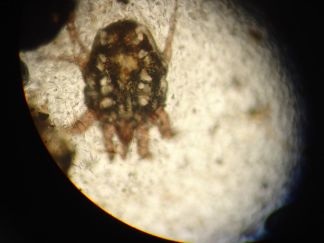
Cat Ear Mites
Veterinarian Reviewed on April 1, 2014 by Dr. Janice Huntingford
Cat Ear Mites (Feline Ear Mites)
Signs and Symptoms
Ear mites are tiny, spider-like insects that infest feline ears, cause bacteria and yeast infections, and are often the source of much irritation and discomfort. If left untreated, these pesky creatures can cause serious damage, rupturing the cat’s eardrum, causing deafness, and spreading infections to the brain with deadly results. Therefore, for your cat’s health, comfort, and well-being it’s important to get rid of cat ear mites as soon as possible. Knowing what signs to watch out for can help you catch a case of ear mites in its early stages, allowing for prompt treatment and quick relief for your pet.
Ear mites move around inside your cat’s ears, and this causes itching and irritation. Furthermore, many cats are sensitive to components in the saliva of the ear mites, which causes more irritation and discomfort. As result, one of the most common symptoms of an infection of ear mites is frequent head shaking and scratching or pawing at the ears. When these behaviors become vigorous, your pet may end up with scratches on its face and in its ears. Although head shaking and ear scratching are the most typical behaviors exhibited by animals with ear mites, it’s still possible for a cat to be infected with these insects and not show these warning signs. This is due to the fact that some cats do not exhibit the hypersensitivity to the mites’ saliva, and therefore are not as troubled by the presence of these creatures. Older cats may be less likely to experience the same level of irritation as younger cats, as it is thought that felines can build up a resistance to the irritating components of ear mite saliva.
Whether or not your cat experiences significant irritation caused by the presence of ear mites, you can keep an eye out for other symptoms and warning signs as well. For instance, ear mites stimulate the wax-producing glands in feline ears. Thus, another common symptom of an ear mite infection is increased earwax. In addition, a cat with ear mites will typically have a dark discharge from its ears. This discharge often resembles coffee grounds and is comprised of earwax, blood, biochemicals, and the actual ear mites. Another sign of cat ear mites is a bad odor accompanying this dark discharge. If you observe your cat exhibiting any of the above symptoms or behaviors, it’s important to have your pet examined by a veterinarian as soon as possible. This will allow for prompt and proper treatment, which will prevent any serious consequences of the infection and will put an end to your cat’s discomfort.
Diagnosis
A case of cat ear mites is relatively easy for a qualified practitioner to diagnose. A veterinarian can be quite confident that ear mites are the cause of a feline patient’s discomfort if the cat is young and shows clinical signs and symptoms such as the typical dark discharge. However, further steps can be taken in order to confirm a diagnosis of ear mites. First of all, a veterinarian will likely use a lighted otoscope to examine the feline’s ears. The light from this instrument attracts the ear mites, drawing them out of the earwax. As these insects move around on the dark wax, they can be quite easily spotted. For further examination, the practitioner might take a sample of the discharge and examine it under a microscope. Ear mites and their eggs are easily viewed under low-power magnification, while the yeast and bacteria typical of a mite infection are visible under high-power magnification.
In situations where the cat’s ears are very sore, the animal may need to be sedated in order for proper examination and treatment to be carried out. It’s very important to have this condition diagnosed by a qualified veterinarian, rather than trying to diagnose it on your own. Sometimes symptoms may appear to be indicative of an ear mite infection when they are actually signs of another condition. If you try to treat your cat’s ear infection with the wrong type of medication, you can actually end up making the problem worse. As result, it’s always important to have a veterinarian perform an examination and confirm a diagnosis.
Pathophysiology
Understanding what cat ear mites are all about can help you to treat and care for your pet when he or she is suffering from a troubling infection. Having some basic knowledge on the subject can also help you to prevent future infections, or at least to catch them in their early stages. Ear mites are tiny, eight-legged insects that live out most of their lifecycle inside an animal’s ears. It’s possible to see these critters with the naked eye and they are easily seen with the use of a microscope. When viewed without any magnification instruments, ear mites appear as small white dots against the darker background of earwax.
The most common type of mite to infect feline ears is otodectes cynotis, and these creatures are responsible for more than fifty percent of cat ear infections. Otodectes cynotis are external parasites that either live on or just beneath the surface of a cat’s skin. The entire lifespan of an adult ear mite lasts approximately two months. These adults lay eggs in the host animal’s fur and ear canals. After about four days of incubation, these eggs hatch and release the larval form of the ear mite. The larvae then transform into nymphs, which then turn into adult ear mites. During their adult phase, these insects live in the ear canal, feeding upon earwax, oils, and other debris.
While these pesky insects generally spend their entire life in the fur and ears of the host animal, they are capable of surviving for a time away from a host. Unfortunately, this contributes to the contagiousness of ear mite infections, as the insects can be easily passed directly from animal to animal, or even from an infected animal to the surrounding environment, where a previously uninfected animal can then pick them up at a later time. For this reason, if you have a multi-pet household, all of the animals may require treatment for this condition.
Causes
The most common way for a cat to become infected with ear mites is through contact with an animal that is already host to these insects. This may occur through the sharing of living quarters, as in a multi-pet household or a shelter, or through animals playing and socializing together. However, as suggested earlier, direct contact is not necessarily required in order to transmit ear mites from one cat to another. Since ear mites can survive for some time away from a host, they may be picked up from the environment, whether outside in the grass or on bedding or some other material. Therefore, even if your cat lives in a single pet household, it’s still possible for him or her to become infected with ear mites.
Certain felines are more susceptible to developing this type of ear infection than others. Cats that are at the highest risk for contracting ear mites are kittens, cats with poor immune systems, abandoned kittens, and cats that live in animal shelters. As alluded to previously, older cats are generally less susceptible to ear mites as they build up a resistance to these insects over the course of their life.
Treatment
Once your cat has been diagnosed as having ear mites, treatment will be required in order to rid your pet of these pesky and irritating insects. The most typical form of treatment involves medication designed to kill the ear mites. Since, at all times, there will be ear mites present in all different stages of the mite lifecycle, medication usually needs to be administered for approximately three weeks in order to ensure that all of the insects are killed. However, before any medications are used, it’s important for the cat’s ears to be cleaned in order for the treatment to work effectively. Removing discharge and debris from the ear canals will get rid of some of the mites and will also allow the medication to reach the affected areas. This cleaning should be done by a veterinarian because, when done improperly, it can cause damage to the cat’s ears.
There are also homeopathic remedies consisting of natural ingredients that will help to reduce symptoms and relieve your pet’s suffering. Some substances that such products may contain include natural oils that serve to drown and suffocate ear mites. In addition, ingredients like azadirachta and allium sativum have disinfectant and antibacterial properties that help to treat and prevent infections. Other substances such as calendula officinalis have a beneficial effect upon inflammation and also promote the healing of wounds. As a result, homeopathic remedies can be very helpful with respect to treating ear mites and increasing your pet’s comfort. However, no form of treatment, whether conventional or natural, should be initiated without first consulting with a qualified veterinarian.
Sign up for our newsletter and receive more articles and the latest pet health updates and special offers.
Our Expert
 Dr. Janice Huntingford
Dr. Janice HuntingfordJanice Huntingford, DVM, has been in veterinary practice for over 30 years and has founded two veterinary clinics since receiving her Doctor of Veterinary Medicine at the Ontario Veterinary College, University of Guelph. She has studied extensively in both conventional and holistic modalities. Ask Dr. Jan


